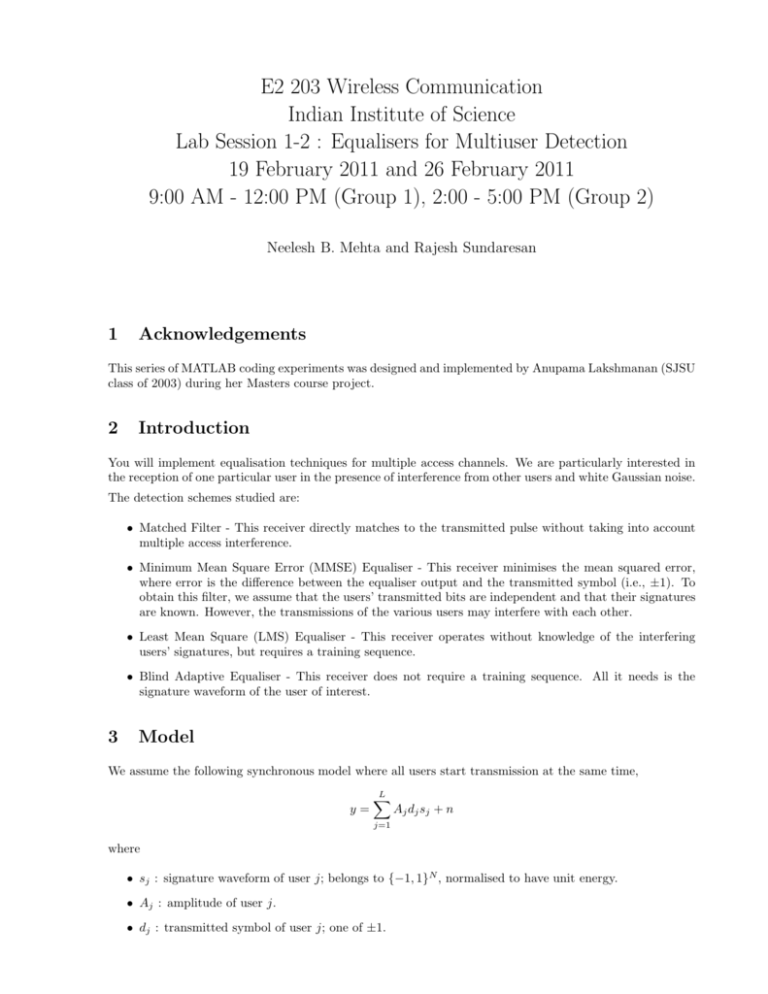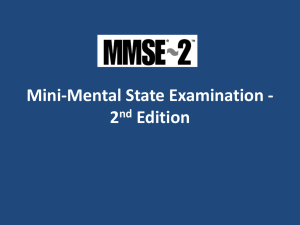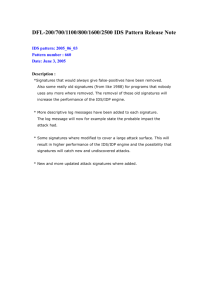Lab Session 1
advertisement

E2 203 Wireless Communication
Indian Institute of Science
Lab Session 1-2 : Equalisers for Multiuser Detection
19 February 2011 and 26 February 2011
9:00 AM - 12:00 PM (Group 1), 2:00 - 5:00 PM (Group 2)
Neelesh B. Mehta and Rajesh Sundaresan
1
Acknowledgements
This series of MATLAB coding experiments was designed and implemented by Anupama Lakshmanan (SJSU
class of 2003) during her Masters course project.
2
Introduction
You will implement equalisation techniques for multiple access channels. We are particularly interested in
the reception of one particular user in the presence of interference from other users and white Gaussian noise.
The detection schemes studied are:
• Matched Filter - This receiver directly matches to the transmitted pulse without taking into account
multiple access interference.
• Minimum Mean Square Error (MMSE) Equaliser - This receiver minimises the mean squared error,
where error is the difference between the equaliser output and the transmitted symbol (i.e., ±1). To
obtain this filter, we assume that the users’ transmitted bits are independent and that their signatures
are known. However, the transmissions of the various users may interfere with each other.
• Least Mean Square (LMS) Equaliser - This receiver operates without knowledge of the interfering
users’ signatures, but requires a training sequence.
• Blind Adaptive Equaliser - This receiver does not require a training sequence. All it needs is the
signature waveform of the user of interest.
3
Model
We assume the following synchronous model where all users start transmission at the same time,
y=
L
X
Aj dj sj + n
j=1
where
• sj : signature waveform of user j; belongs to {−1, 1}N , normalised to have unit energy.
• Aj : amplitude of user j.
• dj : transmitted symbol of user j; one of ±1.
• n : white Gaussian noise vector composed of zero mean and unit variance components.
• y: received signal vector bearing signal, interference and noise.
4
Implementation
All receivers will be of the form
dˆ1 = sign(ct y)
i.e., we restrict our attention to linear Multi-User Detectors (MUD). Note that we are interested only in the
detection of user 1’s transmitted symbols.
You will implement the following receivers.
(a) Matched filter : c = s1 .
h
i
2
(b) MMSE : This receiver minimises E (d1 − ct y) . The solution is given by
−1
L
X
c = A1
A2j sj stj + σ 2 IN s1 ,
j=1
where IN is the N × N identity matrix, and σ 2 = 1. Note that the MMSE is given by
MMSE = 1 − A1 ct s1 .
(c) LMS : This is an iterative procedure that works with training across several symbols periods. At time
k, let the error be denoted by
e(k) = d1 (k) − ct (k − 1)y(k).
Take c(0) = s1 . Then the adaptation rule is given by
c(k) = c(k − 1) + 2µe(k)y(k).
where µ is a positive real parameter.
(d) Blind adaptive equaliser : We write
c = s1 + x1 , where ||s1 || = 1 and st1 x1 = 0,
(1)
i.e., the equaliser has a signal component equal to the normalised matched filter and an orthogonal
component. The adaptation rule adapts the orthogonal component by attempting to minimise E[(ct y)2 ]
subject to the constraints in (1). The adaptation rule is given by
x(k) = x(k − 1) − 2µZ(k)(y(k) − ZMF (k)s1 ),
where
Z(k) = ct (k − 1)y(k),
ZMF (k)
c(k)
= st1 y(k),
= s1 + x(k).
Note that this algorithm does not require any training sequence. Neither does it require knowledge of
interfering users’ signatures. All it needs is the desired user’s signature.
5
References
[1] U.Madhow and M.L.Honig, “MMSE interference suppression for direct-sequence spread-spectrum CDMA”,
IEEE Transactions on Communications, vol. 42, no. 12, pp 3178-3188, December 1994.
[2] M.Honig, U.Madhow and S.Verdú, “Blind adaptive multiuser detection”, IEEE Transactions on Information Theory, vol. 41, no. 4, pp 944-960, July 1995.
[3] S.Verdú, Multiuser Detection, Cambridge University Press, NY, USA, 1998.
2
6
Specific steps
1. Create a function data = randBinary(numUsers, numSymbols) whose output is a matrix of size
numUsers × numSymbols that contains equilikely ±1 data symbols.
2. Write a main program to test your randBinary function. The output data symbols should be printed
on the screen. Test for several numUsers and several numSymbols.
3. Create a function signatures = getSignatures(numUsers, sf, ρ) whose output is such that the
ith row is the signature sequence for user i. You may assume sf is a power of 2. The correlation
between user 1 and user 2 (st1 s2 ) should be as close to ρ as possible. All others users’ signatures should
be randomly generated. All signatures should have unit energy.
4. Append your main program to test getSignatures. Do this by printing out signatures for various
values of sf, numUsers, ρ and verifying they are correct via prints on screen. For the rest of the
session, use ρ = 0.4.
5. Create a function rxIntf = generateInterference(signatures, data, A) that is a vector of received signal (without noise) of size 1× (sf · numSymbols), where A is a vector of gains. No loops.
6. Update your main program to test generateInterference via prints on screen. Verify for different
values of A as well.
7. Create a function rxSignal = getRxSignal(rxIntf, variance) that models the received signal embedded in zero-mean white Gaussian noise of variance variance. The output vector should be 1 ×
sf · numSymbols in size.
8. Update your main program to test getRxSignal via prints on screen. Verify match with rxIntf for
variance = 0. Do this for two users with A = [1, 2]. Then reshape rxSignal to a matrix of size sf ×
numSymbols. Each symbol period of received symbols should be in one column. For subsequent steps
set variance = 1.
9. Create a function errorRateMF = MF(signatures, rxSignal, data). The output should be the
error rate for matched filter. Do the matched filter on each symbol, compute the number of errors,
and compute the error rate. Note that data is used only for statistics generation. No loops.
10. Update your main program to test the above function. Set A = [1, 0]. Verify error rate for numSymbols
= 10000 matches with theory (Q function evaluated at an appropriate point).
11. Create a function [errorRateMMSE, estimatedMMSE, MMSE, cMMSE, MSETrajectory] = MMSE(signatures,
rxSignal, data). The output should be the error rate, estimated MMSE, and true MMSE computed
using formula, the MMSE filter, a trajectory of the MSE over time. (No loops. Use backslash or
mldivide for computing R−1 x).
12. Update your main program to test the above function and plot the MSE trajectory. Set A = [1, 0].
The estimated MMSE should be close to the true MMSE for numSymbols = 10000. What should the
MMSE filter be for this case? What should the error rate be for this case? For subsequent tests, set
A = [2, 1].
13. Create a function [errorRateLMS, squaredErrorTrajectory, cLMS] = LMS(signatures, rxSignal,
data, µ). The output should be the error rate averaged over time, the squared error at each time
instant, and the converged LMS filter. Use the formulae provided. (A for loop is allowed for the time
updates).
14. Update your main program to test the above function. Use numSymbols = 500. Take µ = 0.0001.
Get a plot of the quantity squaredErrorTrajectory versus time. Compare with MMSE filter’s
MSETrajectory. Compare cLMS and cMMSE.
15. Create a function [errorRateBlind, energyTrajectory, cBlind] = blind(signatures, rxSignal,
data, µ). The vector energyTrajectory should have kth component Z(k)2 . Use the formulae provided. (A for loop is allowed for the time updates).
16. Update your main program to test the above function. Use numSymbols = 500. Plot the energyTrajectory
versus time. Compare the cBlind with cMMSE. What is the
17. (Reading and homework questions) To which filter does the LMS algorithm converge? The blind
adaptive algorithm?
3








